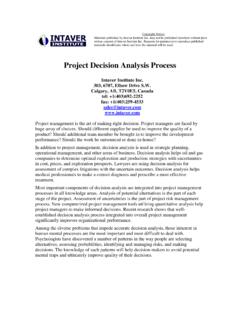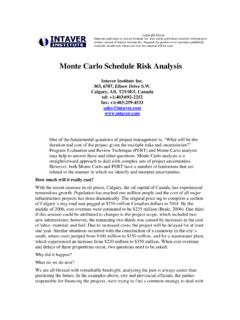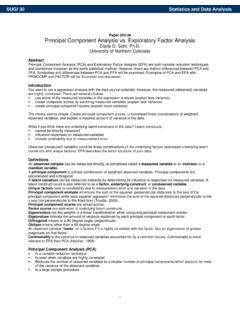Transcription of Project Risks Analysis: Sensitivity Analysis and …
1 Copyright Notice: Materials published by Intaver Institute Inc. may not be published elsewhere without prior written consent of Intaver Institute Inc. Requests for permission to reproduce published materials should state where and how the material will be used. Project Risks Analysis : Sensitivity Analysis and Correlations Intaver Institute Inc. 303, 6707, Elbow Drive Calgary, AB, T2V0E5, Canada tel: +1(403)692-2252 fax: +1(403)259-4533 Identifying which activities have the most affect on the Project and understanding how activities are correlated with each other is important for establishing Project priorities.
2 Our judgment about correlation and causation is affected by a number of biases, such as illusory and invisible correlations, covariation assessment, and others. Sensitivity Analysis helps to discover correlations within a Project . What Are Correlations And Why Do We Need to Analyze Them? On January 21, 2005 the state of Maine officially launched its new Medicaid Claim System (Holmes, 2006). This web-based software system was designed to process $ billon in Medicaid claims and payments per year. However, a problem surfaced within the first few days: the new system started to mistakenly reject a huge number of claims from service providers: doctors, hospitals, dentists, and others.
3 By the end of March, the system suspended (unpaid) 300,000 claims. It soon became clear that the system was plagued by numerous software bugs. With the huge number of claims rejected, several doctors were forced to close their doors; others had to take loans to continue operation. This was only a small symptom of a larger problem. The Medicaid program accounted for one-third of the entire state budget and, as a result of the software problem, Maine s financial stability was in jeopardy. By the end of summer 2005, the system had a backlog of 647,000 unpaid claims representing $310 million in back payments.
4 It soon became clear that the problem was due to poor Project management, and in particular, communication between state s IT team, contractors and business users. One of the most critical issues was related to the prioritization of the Project tasks. The IT staff had worked extremely hard trying to fix every possible bug without a clear understanding of what were the most important issues to focus their efforts on. In essence, they had given all the issues the same priority without regard to how they affected the system. A new Project manager quickly moved to prioritize the Project s activities.
5 The software developers were asked to fix the bugs that were causing the largest number of suspended claims. Other activities that were assigned a lower priority such as improvements to the system s user interface would be addressed later. By improving the lines of communication, setting up priorities, and improving other Project management processes, the claim system started to get back on track. One of the problems that Project managers and teams face is that human beings are not built to think about different things simultaneously. Project teams cannot deal with all the tasks and all the issues at the same time.
6 Tasks that have the most effect on the Project schedule and Project deliverables require the most attention. Activities that require the most attention often carry the most risk and may require significant mitigation efforts; therefore, we must identify them before the Project starts. Essentially, we need to be able to analyze the correlations between the main Project parameters (duration, cost, finish time, and others) and each task s parameters. Another important issue is to understand how correlations between different activities affect the Project .
7 You know that your supplier may be very busy. If your activity is delayed because the components did not arrive on time, other activities, which use component from the same supplier, can also be delayed. Similarly there can be synergies between different projects. These correlations will significantly affect the course of the Project . In addition, when you plan your Project , you should determine which Project management activities and procedures would be most effective for this particular Project . For example, for some teams a ten-minute meeting every morning to coordinate team activities is very useful, but in others it can be an utter waste of time.
8 In other words, you need to find a correlation between Project management activities and Project results. To do this, we need to: 1. Identify which activities have the most affect on the Project to set up our priorities. 2. Understand how different projects and activities within the Project are correlated with each other and analyze the effect of these correlations on the Project . 3. Identify particular Project management processes and procedures that address the effects of these correlations so that they can be adopted by your team or organization.
9 Sources of Correlation in Projects In what manner are different tasks in a Project correlated? Schuyler (Schuyler, 2001) names three different sources: Common Drivers: Different Project parameters may share a common influence. For example, changes in Project scope will affect many tasks. If there is an issue with resource, all tasks in which this resource is employed will be affected. Common Constraints: If different Project activities are competing for the same resources, these activities will be correlated. For example, technological constraints will affect all of the activities using this technology.
10 Common Cause: Results of one activity will lead to changes in another activity. For example, design changes that occur during the course of one activity, may affect many other activities. Psychology of Correlation and Causation Usually Project managers believe that setting up priorities is a trivial task, which they can accomplish quickly and without any tools. But if it is so easy, why do so many projects start without any prioritization when the failure to do so often results in missed deadlines, poor quality, and huge cost overruns? The answer lies, as it does in so many things, in human nature.










